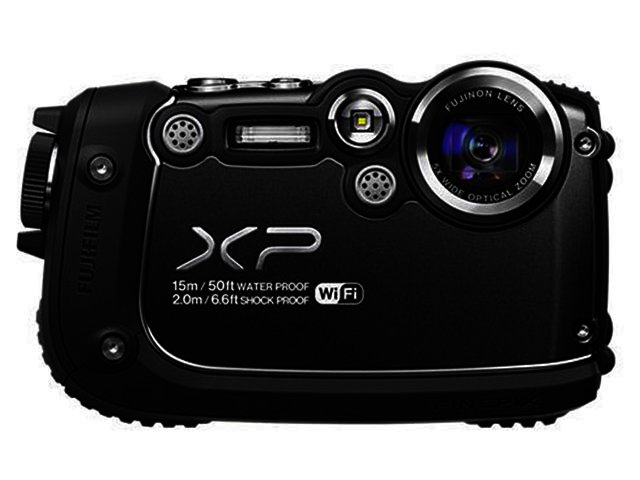There have been plenty of compact cameras that have checked in to our review desk over the past few years. However, every so often, one comes along that, on its surface at least, reminds us what we love about cameras in general.
The FinePix XP200 is one such offering, melding an attractive chassis and ergonomic design, with a ready-for-the-rough feel that only made us sorry we weren’t near a rapid-running river or verdant mountain ripe for a good outdoor excursion. Indeed, going by looks and design alone, for a moment, we dare say the XP200 would fit right in at either of these locales.
Dreams of adventures aside though, the XP200 is certainly an attractive camera, with mostly rounded curves and plenty of rubberised sealing to keep water out. It is on the chunky side, although this is not necessarily a con in our book, particularly not for a camera that is meant to promise durability.
Ready for adventure
To this end, the camera is both waterproof to 15 metres, freezeproof to -10 degrees centigrade and shockproof to two metres; clearly Fuji intends for users to subject it to some abuse, whether wilful or more likely, accidental.
Further cementing this is the fact that the battery, SD card and HDMI port are all protected behind a sturdy, lockable dial which has to be disengaged to break the rubber sealing before these precious innards can be accessed.
Image wise, you have 16 megapixels to play with, while the ISO range is a not too shabby at all 100 to 6400, with up to two stops exposure compensation possible in 1/3 increments.
Also worth noting is that controls and dials are kept to a minimum here, with just rubberised buttons for controlling the zoom, a dedicated video button, the menu button with a scattering of other buttons for previewing images, switching macro on or off and doing likewise to the flash.
.jpg)
Buttons are minimalist on the camera's back, with most functions accessed from the menu.
Surrender control, embrace speed
Although the minimalist controls mean you have to delve into the menu to change most settings, this was a relatively painless affair, since Shooting Mode is the first option that greets you when pressing the menu button. Just beneath it are other commonly accessed settings, such as ISO speed, image size, image quality and white balance.
Here, however, is the kicker – in keeping with its target market – no doubt active outdoor shooters, the camera boasts a very good burst mode, conveniently accessed via a dedicated button beneath the zoom. This enables you to capture up to a claimed 10 fps (for nine frames) at full resolution, although, in our tests this was closer to a still very good 8 fps.
Also, we were particularly pleased by the quickness of the camera’s auto-focusing, as we encountered no annoying hunting when capturing images with it, despite seeking out less than ideal lighting.
Quality time
As for quality, we were quite impressed by the richness of the colours and dynamic range on offer, particularly at ISO 100 and ISO 200. Quality does begin to drop off from the ISO 400 and up mark, with noise becoming increasingly evident, and while the camera boasts ISO 6400, our suggestion would be to rather suggest limiting yourself to ISO 3200.
Naturally, also onboard is video, happily given its own dedicated button as well, and this delivers full HD (1920x1080) and 720p video (1280x720) at an admirable 60 fps. Alternatively, you can rather decrease the video resolution down to 320x240 or 224x168 and garner 240 fps and 360 fps respectively.
Finally, and this might serve as a reminder that the camera does not just beckon you to go find a happy hiking trail, but also serves up a dollop of connectivity as well – as the XP200 has onboard Wi-Fi for seamlessly transferring images from the camera’s SD card to your mobile device of choice, sans wires or card adapters. Instead, this is accomplished using Fujifilm’s freely available camera app (available for both iOS and Android).
Also worth mentioning is the 3” screen itself, which boasts an impressive 920 000 dot resolution, normally found on cameras the likes of the g15.

At ISO 200. we were actually quite pleased with the camera's dynamic range and with how well it coped with a highly contrasty scene.

By ISO 1600, you really notice the drop in quality and sharpness, as well as the presence of noise.
Bumps and bruises
While there is plenty to like about the X200, it is not without its issues and omissions. With regards to the former, one design issue to be aware of is that it can be all too easy to inadvertently capture a portion of your left hand when holding the camera, as the 5x optical zoom (28-140mm equivalent) is positioned close to the upper left corner of the camera, and the lens seemed to be prone to flare, even when shooting with the camera in the shade.
It also has the odd design choice that requires users to open the aforementioned watertight battery compartment in order to charge the battery with the included cable. This, despite the fact that the battery is removable, and if a charging dock was provided, would obviate having to leave that compartment open for long stretches.
Additionally, while the camera boasts a plethora of shooting modes, including HDR, motion panorama 360 and individual shutter 3D (also useful for creating multiple exposures), aperture priority and shutter priority are not amongst them; an omission of which we did miss.
Finally, also marring an otherwise enjoyable experience, is the fact that the 3” screen didn’t fare too well in sunlight, direct or otherwise.
To the point
In the final analysis, the XP200 is still one of those cameras that we actually thoroughly enjoyed, despite its imperfections, and which ultimately wormed its way into our heart. This is a camera we could well see in the hands of hikers and other outdoor enthusiasts; additionally, it should not be overlooked for parents seeking a hardy compact camera for the kids, which could withstand being dropped by them as well.
We suspect that a good amount of love and attention has gone into producing this camera, as it impressed and won us over a little bit, perhaps if anything, as it reminded us of the adventure of photography. It has an RRP of R3 300.
Pros
Well built and ruggedized
Ergonomic in one’s hand
Onboard Wi-Fi for easily transferring photos to your mobile device
Responsive autofocus
Cons
Lens prone to flare
Screen does not hold up well in sunlight





